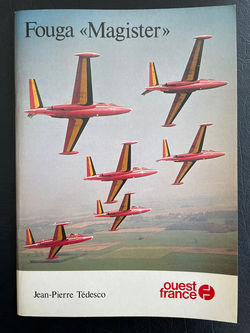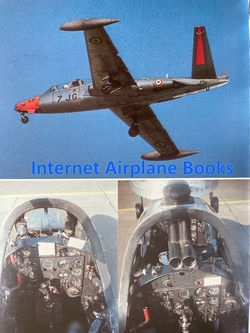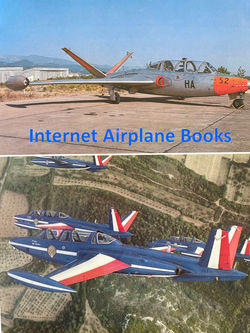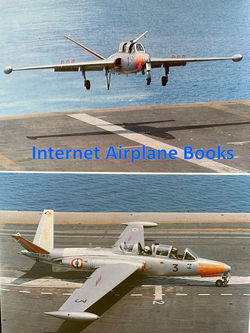OUEST FRANCE
FOUGA CM 170 MAGISTER ZEPHYR JET TRAINER FRENCH AF NAVY AERONAVALE
SOFTBOUND BOOK in FRENCH BY JEAN-PIERRE TEDESCO
----------------------------------------
Additional Information from Internet
Encyclopedia
The Fouga CM.170 Magister is a 1950s French
two-seat jet trainer aircraft, developed and manufactured by French aircraft
manufacturer Fouga. Due to industrial mergers, the aircraft has been variously
known as the Fouga CM.170 Magister, Potez (Fouga) CM.170 Magister, Sud Aviation
(Fouga) CM.170 Magister and Aérospatiale (Fouga) CM.170 Magister, depending on
where and when they were built.
In 1948, development commenced at Fouga on a new
primary trainer aircraft design that harnessed newly developed jet propulsion
technology. The initial design was evaluated by the French Air Force (Armée de
l'Air, AdA) and, in response to its determination that the aircraft lacked
sufficient power for its requirements, was enlarged and adopted a pair of
Turbomeca Marboré turbojet engines. First flying on 23 July 1952, the first
production order for the type was received on 13 January 1954. Export orders
for the Magister were received, which included arrangements to produce the type
under license in West Germany, Finland and Israel. In addition, the related
CM.175 Zéphyr was a carrier-capable version developed and produced for the
French Navy.
While primarily operated as a trainer aircraft,
the Magister was also frequently used in combat as a close air support platform
by various operators. In the latter capacity, it saw action during the Six-Day
War, the Salvadoran Civil War, the Western Sahara War, and the Congo Crisis. In
French service, the Magister was eventually replaced by the Dassault/Dornier
Alpha Jet. After its retirement by the French Air Force, Magisters were
purchased by several private-owner pilots in the US and have since been
operated in the experimental category.
Development
During 1948, aircraft designers Robert Castello
and Pierre Mauboussin at French aircraft manufacturer Fouga embarked upon the
design of a new jet-propelled primary trainer aircraft, initially designated as
the CM.130, intended for the French Air Force (Armée de l'Air, AdA) as a
replacement for piston-engined Morane-Saulnier MS.475 aircraft. The AdA
reviewed the project and found that the aircraft lacked power from the two
Turbomeca Palas turbojet engines selected for the aircraft; in response, Fouga
proceeded to enlarge the basic design, which was equipped with the more
powerful Turbomeca Marboré engine and retaining the distinctive butterfly tail
of the Fouga CM.8 glider, which had been used by Fouga for jet engine research.
During December 1950, the AdA placed an order for
three prototypes; on 23 July 1952, the first aircraft conducted its maiden
flight. During June 1953, a pre-production batch of 10 aircraft were ordered,
which was followed by an initial production order for 95 aircraft on 13 January
1954.[1] By October 1955, all 13 preproduction Magisters had been completed,
while the first flight of the first production aircraft was imminent. Also
scheduled to fly early in 1956 was the CM.171, which functioned as a test
aircraft for the envisioned CM.195 swept-wing, butterfly-tailed trainer.
In order to manufacture the type, Fouga opened a
new assembly plant at Toulouse-Blagnac within a newly built complex. According
to aviation publication Flight International, any export orders that were
received were typically given priority over the existing orders which had been
issued by the French government; this policy allowed for overseas countries to
procure aircraft directly "off the line" with minimal delay between
receipt of orders and the corresponding deliveries.
The Aéronavale (French naval air arm) decided to
adopt a carrier-capable derivative of the Magister, the CM.175 Zéphyr, which
served as a basic trainer for deck-landing training and carrier operations.
These were preceded by two "proof of concept" prototypes, designated
the CM.170M Magister, which performed their first flights in 1956 and 1957
respectively.
By 1960, in excess of 350 Magisters had entered in
service with various operators; according to Flight International, production
within France had attained a completion rate of five aircraft per month, while
the projected total of French-built Magisters was reportedly expected to
eventually top 600 units. The type was also being produced overseas under
licensed production arrangements in West Germany, Finland and Israel.[5] The
first export customer for the Magister was West Germany, who placed an initial
order for 62 aircraft directly from Fouga; a further 188 aircraft were produced
by Flugzeug Union Süd (a consortium of Heinkel and Messerschmitt)[6] under
license.[1] In addition, the Magister was also constructed under license by
Finnish company Valmet and by Israeli firm Israel Aircraft Industries (IAI). As
a result of these arrangements, a combined total of 286 aircraft were completed
under license.
From 1960, an improved version of the Magister,
designated the CM.170-2 Magister, was produced, which was powered by a more
powerful Turbomeca Marboré IV engine. During 1962, production of the Magister
was terminated in France but continued to be constructed under licence in
Finland up to 1967. The development of the aircraft had been brought to an end
in response to the AdA selecting the rival Alpha Jet as its new jet trainer
instead.
Design
The Fouga CM.170 Magister was developed to perform
both basic and intermediate training activities.[7] It is a compact, tandem
seat aircraft with performance akin to larger, more powerful aircraft.
Comparatively, it was a higher performance aircraft than the rival
British-built BAC Jet Provost, and was considered by the Aviation magazine
Flight International to be comparable to Fokker S.14 Machtrainer.[8] It
featured a distinctive butterfly tail configuration; a conventional tail was
tried but found to be aerodynamically inferior at higher speeds. A keel fitted
under the rear fuselage functions to reduce the negative dihedral effect of the
butterfly tail during rudder applications.
The Magister was powered by a pair of Turbomeca
Marbore turbojet engines, which provided 880 lb of thrust each; it was promoted
as offering "twin-engine safety with single-engined flying
characteristics". The two engines, which were placed close to the centre
line, produced very little asymmetric thrust as a consequence; this was viewed
as a valuable safety feature for a trainer aircraft.[10] While viewed as an
uncommon instance, in the event of a single-engine flameout the relighting
procedure was relatively quick and easy to perform. The rate of acceleration
and rate of climb were less than contemporary frontline jet fighters, such as
the de Havilland Vampire and Gloster Meteor, but was in excess of many of the
previous generation of piston-engined trainer aircraft.[11] The engines shared
a common fuel system, but had independent oil systems; for extended range, tip
tanks were provided as standard equipmnt.
The desig of the Magister paid close attention to
simplicity of operation; as such, a minimum number of procedures were necessary
prior to take-off.[13] Accessibility to both the engines and onboard equipment
for servicing was above average; it was possible for both of the type's Marbore
engines to be swapped out within 45 minutes. Provision was made for the
installation of a pair of 7.5 mm guns upon the aircraft's nose, which included
a 200-round ammunition box for each gun and the ability to collect both links
and cases. Underwing hard points could be used to hold up to four rockets or a
pair of 110 lb bombs.[4] A landing light was installed in the tip of the nose
while a retractable taxiing light was installed upon the Messier-built
nosewheel.[4] The landing gear was satisfactory for operations from austere
grass airstrips.
The Magister was typically outfitted with avionics
such as very high frequency (VHF) radio systems, Lear radio compass, and
intercom; all cockpit electronics conformed to NATO accessibility
standards.[15] It was not provided with ejector seats in standard, but the
fitting of various units was considered to be available upon request. The
assorted levers, switches and dials that comprised the cockpit displays were
typically easily observable, while ample room was provided for pilot comfort
and space to accommodate a parachute.[16] The standard blind panel is ahead of
each pilot, and engine instruments are set to the left, while underneath these
are the flap indicator, flap switch and emergency selectors, along with the two
throttles and fuel cocks; the right forward bench carries the radio panel, and
to the extreme right of that are the armament controls. The cockpit was
pressurized as well as being provisioned with a fresh air system.
The pedals were adjustable and had fairly
permissible limits, while the cockpit itself was relatively easy to access, the
canopy opening upwards and rearwards while using only a single step due to its
low height.[16] In order to account for the poor forward visibility available
to the rear seat, usually occupied by the instructor, the front screen was
bulged and a binocular periscope was fitted, providing a relatively clear
perspective over a relatively wide angle over the top of the front cockpit. The
forward cockpit, normally used by the student, provided for excellent external
visibility.[13] According to Flight International, the Magister was able to
perform various aerobatic manoeuvers "effortlessly", the flight
controls were light and relatively well harmonized, and the stick has a firm
sense of feel.[11] It had a high level of lateral stability in flight, as well
as being fairly directionally stable as well, allowing the aircraft to, when
properly trimmed, be flown hands-off for indefinite periods.








